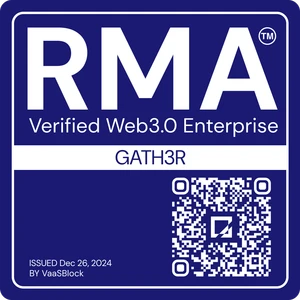Organization Name – Gath3r
Category –  Experiences
Experiences
Gath3r positions itself as a “Web3 compass,” a search‑and‑discovery engine built to map the fast‑changing landscape of decentralized projects, protocols, and communities. The platform was …quietly incorporated in Bangkok in October 2023 by Thai entrepreneur and community strategist Pichapen Prateepavanich, who says she became frustrated by “fragmented, hype‑driven information” dominating crypto chats and wanted a single place where trustworthy data on coins, NFTs, wallets, tooling, events, and jobs could live. According to the team’s LinkedIn blurb, the directory already lists more than 30,000 Web3 entities drawn from user submissions, project feeds, and manual curation
In a newsletter interview last year, Prateepavanich claimed the figure had surpassed 40,000 listings and emphasised that every entry is “community‑driven, with reviews and ratings designed to weed out inflated marketing claims and outright scams”
That grassroots ethos underpins the product’s pitch: Gath3r is less a conventional crawler like Google and more a collaborative yellow‑pages where participants themselves vouch for what deserves to be found.
The site, accessible at Gath3r.co, is architected as a hybrid Web2/Web3 experience. Static front‑end pages load from traditional servers, but the underlying index—tokens, contract addresses, social accounts, audit links—is mirrored to IPFS so that, in theory, the directory cannot be censored or altered without leaving an on‑chain trail. Search queries route through an AI‑assisted ranking layer the company calls “Trust Score,” which weighs crowd‑sourced ratings, GitHub activity, smart‑contract age, audit status, and social sentiment. While the exact weighting remains proprietary, Gath3r argues the model surfaces battle‑tested projects ahead of newly launched clones, addressing a common pain point for newcomers overwhelmed by pump‑and‑dump noise. This approach aligns with broader industry commentary that Web3 search engines will likely pivot around privacy, decentralisation, and user‑controlled data, rather than the ad‑driven profiling that underpins Web2 giants
Gath3r’s small core team—official filings and LinkedIn data suggest just two to ten employees—leans heavily on its contributor network, rewarding power users with early access to new features and occasional merchandise drops. Prateepavanich, who appears frequently on regional conference panels, frames the effort as “Wikipedia‑meets‑Crunchbase for crypto”: a living database in which anyone can propose edits, but reputation metrics discourage vandalism. Community building has been a personal focus for the founder; she is a regular guest on VaaSBlock’s No Chain No Gain podcast and a confirmed speaker for Southeast Asia Blockchain Week 2025. Industry newsletters have named her an “inspiring community builder,” noting that she actively cross‑pollinates Gath3r with other groups such as WolvesDAO and ARC to keep the listing pipeline fresh
Trust was further emphasised in December 2024 when Gath3r became one of the earliest search platforms to obtain VaaSBlock’s RMA™ (Risk Management Assessment) badge
The audit reviewed governance practices, security controls, and data‑handling policies; VaaSBlock reported that Gath3r met or exceeded benchmarks in every relevant category, an outcome Prateepavanich hailed as proof the directory “puts user safety first.” Sceptics point out that RMA is a nascent framework and that Gath3r has yet to publish a traditional smart‑contract audit, but the endorsement supplies an external layer of diligence for potential partners who might consider integrating the index into wallets or analytics dashboards.
Feature‑wise, the company is shipping fast. A beta plug‑in for popular Web3 wallets lets users highlight any contract address and jump straight to its Gath3r profile, complete with audit links, Discord invite, and tokenomics summary. The team is also prototyping an “Event Mode” that aggregates conference agendas, speaker bios, and ticket drops, reflecting Prateepavanich’s own background in event production. An upcoming “Snapshot Reviews” feature will allow DAO treasuries to embed Gath3r widgets in governance portals, giving token‑holders quick due‑diligence views before voting on grant proposals. Internally, developers are exploring how zero‑knowledge proofs could let projects verify treasury balances or KYC status to Gath3r’s ranking algorithm without exposing raw data—a nod to the privacy demands of institutional users.
While some crypto veterans recall an earlier, unrelated 2019 project named Gath3r that offered in‑browser crypto‑mining for website monetisation, Prateepavanich’s venture is functionally distinct. The company stresses it has “no affiliation with previous projects of a similar name” and decided to brand with a “3” partly to evoke the Web3 ethos. Even so, brand confusion lingers on social media, and the founder routinely clarifies the distinction during interviews.
Commercially, Gath3r remains pre‑revenue. The directory is free to search, and listing requests cost nothing. The roadmap hints at a premium API tier for analytics firms and a sponsored‑listing model—akin to Google Ads but capped at four “featured” spots per query, each label marked “Promoted” to satisfy transparency hard‑liners. The team has floated the idea of a utility token, $GTHR, that would let power users up‑vote listings or unlock granular analytics, but Prateepavanich tells prospective investors the idea will not ship until regulatory clarity improves. In the interim, the business runs on angel funding and a university‑backed innovation grant secured in Bangkok last spring; financial details are undisclosed.
The competitive field is heating up. Privacy‑centric engines like Presearch, NFT‑focused portals such as Pulsr, and niche DeFi dashboards all vie to be the go‑to discovery tool for crypto newcomers. Analysts note that no player yet commands even one‑percent of Google’s overall search traffic; daily active queries across the entire Web3 search sector remain in the low hundreds of thousands. Success therefore hinges less on raw scale and more on carving out credible niches. Gath3r’s bet is that a human‑curated yellow‑pages, underpinned by transparent scoring and community moderation, will resonate with users fatigued by spam‑laden Telegram groups and misleading CoinMarketCap listings.
Early traction is modest but notable. Twitter follower counts hover around a few thousand, and monthly unique visitors to the web app are reportedly “in the five figures,” though these numbers are not yet publicly verifiable. The RMA listing shows an Ethereum contract address tied to a non‑transferable soul‑bound NFT issued to Gath3r as proof of certification, a novelty that dovetails with the platform’s ambition to weave verifiable credentials directly into its data feeds
f partnerships materialise—Prateepavanich has hinted at wallet integrations and DAO tooling—the project could capture a slice of flow from users who prefer directory snapshots over deep‑diving into block‑explorer dashboards.
Challenges remain. Decentralised search is still a moving target; indexing IPFS or Arweave content at scale is resource‑intensive, and layering subjective trust metrics on top invites governance headaches. Techopedia’s overview of Web3 search engines warns that privacy‑preserving design must balance with usability, and that adoption will ultimately hinge on delivering “more personalised and transparent results” without sacrificing speed
Gath3r’s small team will have to juggle feature velocity with rigorous data validation, especially if it opens the APIs to third‑party developers. Regulatory scrutiny is another wildcard: directory services themselves are largely unregulated, but if Gath3r moves into token‑based incentives or paid ratings, securities and advertising rules could apply.
For now, Gath3r offers a tidy, community‑centric starting point for anyone trying to make sense of crypto’s sprawl. Whether you’re a builder hunting for auditors, an investor screening IDO pipelines, or a newcomer seeking reputable NFT marketplaces, the platform promises to surface vetted options faster than endless Twitter threads can. Sceptics will want to see sustained growth and independent audits, but the early signals—a lean team iterating quickly, external certification, and an engaged user base curating tens of thousands of entries—suggest the project is more than just another speculative token chase. If Gath3r can maintain its focus on trust and keep scaling its crowdsourced model, it may well become the web’s equivalent of an old‑school business directory—only this time designed for the decentralized, data‑rich, and often chaotic world of Web3.
Read More
 Experiences
Experiences











